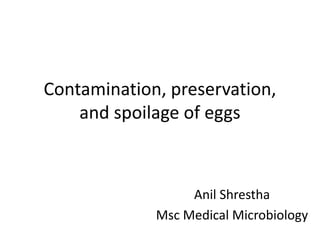
egg 1.pdf
- 1. Contamination, preservation, and spoilage of eggs Anil Shrestha Msc Medical Microbiology
- 2. Contamination • Freshly laid eggs are sterile inside. • The shells of eggs soon become contaminated by fecal matter from the hen, by the cage or nest, by wash water if the eggs are washed, by handling, and perhaps by the material in which the eggs are packed. • The total number of microorganisms per shell of a hen’s egg has been reported to range from 10² to 10⁷ with a mean of about 10⁵.
- 3. • A comparison of the flora of the shell and the flora isolated from spoiled eggs suggest a high number of gram-positive bacteria in former but a low number in the later. Therefore, those organisms which frequently spoil or “rot” the egg are in relatively low numbers initially on the shell.
- 4. Preservation • The egg has various ways of protecting itself from microbial invasion. The shell and the thin surface layer of proteinaceous material known as cuticle or bloom are the first line of defense and serve to retard entry. • A rapid change in storage temperature may permit bacteria to overcome the physical barrier of the shell and its membrane.
- 5. • Changes in the membranes occur with aging and favor more rapid bacterial multiplication. The rates of physical and chemical changes in the eggs depend on the time and temperature of holding, the relative humidity, and the composition of the atmosphere about the eggs. • The character of albumen hinder microbial growth include a pH 9 to 10 that may be reached during storage, lysozyme enzyme which degrade the cell walls of gram-positive bacteria,
- 6. • Asepsis- When eggs are broken for drying or freezing, care is taken to discard those in which microbial growth has taken place to reduce contamination from equipment by cleaning and sanitizing it. • Removal of microorganism- washing with warm, plain water removes dirt. 1-3% acetic acid was effective in removing the flora but resulted in a reduction of shell thickness and egg quality. Lye, acids, formalin hypochlorites, quaternary ammonium compounds, various detergent- sanitizer combinations have been used at temperature from 32.2 to 60 C.
- 7. • Use of Heat- The heat coagulability of the egg white determine to a great extent the maximal heat treatment that can be given shell eggs. 800 sec at 57.5 C; 320 sec at 60 C or above resulted in some coagulation of the white when heat treatments were employed that would control rotting. • Use of low temperature- Chilling:- For commercial storage for 6 months or longer, a temperature of -1.7 to -0.55 C and relative humidity of 70 to 80 percent are recommended.
- 8. • Freezing:- The eggs first are selected by candling and then are washed mechanically with a final rinse in 200 to 500 ppm chlorine and then broken on automatic breaking machine. The eggs are broken, and the contents fall into inspection cups. • The frozen eggs are stored at -17.8 to -20.5 C. • Bacteria that spoil eggs stored at low temperatures, especially Pseudomonas organisms as well as bacteria of the genera Alcaligens, Proteus and Flavobacterium.
- 9. • Use of preservatives Preservatives may be used on the shells of eggs, in the atmosphere around them, or on wraps or containers for eggs. Chemical preservatives used are borates, permaganates, benzoates, salicylates, formates. Use of warm or hot solutions of hypochlorite, lye, acids, formalin, quaternary ammonium compounds and detergent-sanitizer combinations.
- 10. • Use of irradiation Experiments have indicated that pathogens in liquid, frozen and dried eggs can be inactivated by means of ionizing radiation
- 11. SPOILAGE • Changes Caused by microorganism 1) Contaminate the shell 2) Penetrate the pores of the shell to the shell membranes 3) Grow through the shell membranes to reach the white 4) Grow in the egg white
- 12. Bacterial rots • Green rots- Pseudomonas fluorescens • Colorless rots- Pseudomonas, Acinetobacter, Alcaligens and certain Coliform bacteria • Black rots- Proteus melanovogens, Pseudomonas, Aeromonas • Pink rots- Pseudomonas • Red rots- Serratia
- 13. Pin-spot molding • Yellow/ blue/ green spots- Penicillium • Dark-green or black spots- Cladosporium • Pink spots- Sporotrichum Fungal rotting Penicillum, Cladosporium/ Sporotrichum/ Mucor/ Thamnidium/ Botrytis/ Alternaria